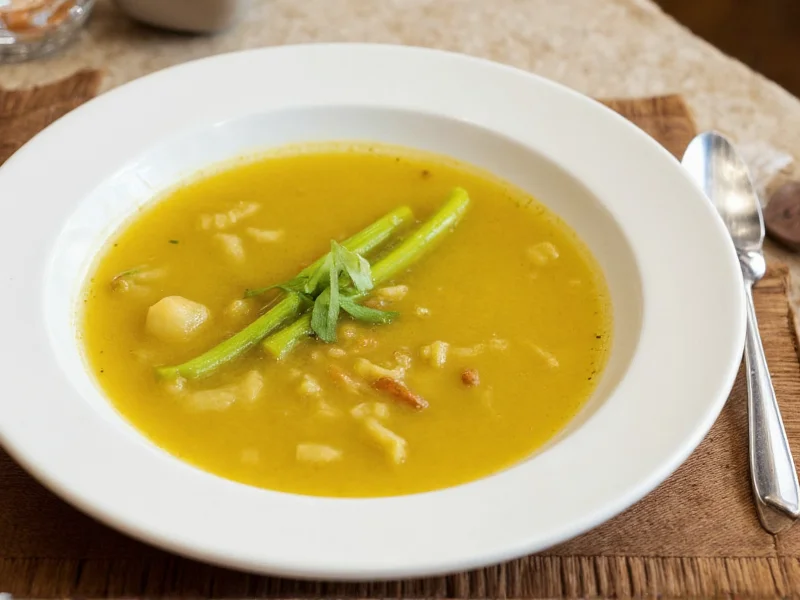The Essential Role of Celery in Soup Making
Celery isn't just another vegetable in your soup—it's a flavor architect. Professional chefs and home cooks alike rely on celery for its unique ability to build complex flavor profiles. The secret lies in celery's natural glutamates and volatile compounds that release savory notes when cooked. Unlike stronger ingredients that can dominate a dish, celery provides a balanced aromatic base that complements rather than competes with other components.
When preparing soup, celery works synergistically with onions and carrots (known as mirepoix in French cuisine) to create what chefs call "the flavor foundation." This trio undergoes the Maillard reaction when sautéed, developing hundreds of flavor compounds that form the backbone of most savory soups. The celery leaves, often discarded, contain even more intense flavor than the stalks and make an excellent garnish or addition to stock.
Nutritional Benefits of Celery in Soups
Incorporating celery into soups significantly boosts their nutritional profile. One cup of chopped celery contains just 16 calories but delivers 14% of your daily vitamin K needs, 5% of vitamin C, and valuable amounts of potassium and folate. When cooked in soups, these nutrients become more bioavailable as the cooking process breaks down celery's fibrous structure.
| Nutrient | Per Cup (Chopped) | Benefit in Soups |
|---|---|---|
| Vitamin K | 30 mcg (35% DV) | Supports blood health and bone density |
| Vitamin C | 5 mg (8% DV) | Boosts immunity and enhances iron absorption |
| Potassium | 260 mg (6% DV) | Regulates fluid balance and supports heart health |
| Dietary Fiber | 1.6 g (6% DV) | Promotes digestive health and satiety |
The Science Behind Celery's Flavor Contribution
Celery's magic in soup making comes from its unique chemical composition. The vegetable contains phthalides, which give it that distinctive aroma and taste. When heated, these compounds transform and interact with other ingredients through complex chemical reactions. The sodium content naturally present in celery (about 80mg per cup) helps enhance overall flavor perception without making the soup taste salty.
Interestingly, the time when you add celery to your soup dramatically affects the final flavor. Adding it early in the cooking process creates a mellow, integrated flavor base, while adding it later preserves more of its distinctive fresh taste. For maximum flavor extraction, chop celery uniformly (about 1/4 inch pieces) to ensure even cooking and optimal surface area for flavor release.
Selecting and Preparing Celery for Soups
Not all celery is created equal when it comes to soup making. Look for crisp, firm stalks with vibrant green leaves. The ribs should snap cleanly when bent, indicating freshness. Avoid celery with yellowing leaves or limp stalks, as these indicate age and diminished flavor.
Proper preparation makes a significant difference in your celery and soup results. Always wash celery thoroughly, as the ribbed structure traps dirt. Trim the base and leafy tops, reserving the leaves for garnish or additional flavor. For most soups, cut celery into uniform pieces to ensure even cooking. When making clear broths, blanching celery briefly before adding to your soup can prevent cloudiness while preserving flavor.
Classic Soup Recipes Featuring Celery
Celery shines in numerous traditional soup recipes across culinary traditions. The classic French pot-au-feu features celery as part of its aromatic base, while Italian minestrone relies on celery for depth. In American cuisine, celery is indispensable in chicken noodle soup, where it contributes both flavor and texture.
For an authentic celery soup experience, try this simple preparation: Sauté 2 chopped celery stalks with 1 diced onion and 1 diced carrot in 2 tablespoons of olive oil until softened. Add 4 cups of vegetable broth, 1 peeled and diced potato, and simmer until vegetables are tender. Blend until smooth, then season with salt, pepper, and a splash of cream. This basic celery soup recipe for beginners delivers restaurant-quality results with minimal effort.
Avoiding Common Celery Soup Mistakes
Even experienced cooks sometimes make critical errors when using celery in soups. One common mistake is adding celery too late in the cooking process for soups that require a developed flavor base. For hearty soups and stews, celery should be among the first ingredients sautéed to build flavor.
Another frequent error involves improper storage of celery, which affects soup quality. Store celery wrapped in aluminum foil in the refrigerator crisper drawer—it will stay crisp for up to four weeks. Avoid storing celery near ethylene-producing fruits like apples or bananas, which accelerate spoilage. When preparing celery soup recipes, always use the inner stalks for their more delicate flavor and tender texture.
Creative Variations and Modern Takes
While traditional celery soup preparations remain popular, contemporary chefs are exploring innovative ways to feature this versatile vegetable. Roasted celery soup with apple and thyme offers a sweet-savory profile that appeals to modern palates. For a creamy texture without dairy, blend cooked celery with white beans or cauliflower.
International variations showcase celery's adaptability. In Asian-inspired soups, celery pairs beautifully with ginger and lemongrass. For Mediterranean flavors, combine celery with tomatoes, olives, and oregano. The key to successful celery and soup flavor pairing lies in understanding celery's role—it should enhance, not dominate, the overall flavor profile.











 浙公网安备
33010002000092号
浙公网安备
33010002000092号 浙B2-20120091-4
浙B2-20120091-4